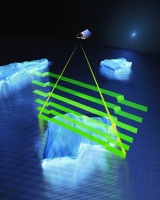CryoSat-2 set to shed new light on climate change
Developed in the UK, CryoSat-2’s radar system will probe Earth’s polar regions in unprecedented detail

To pin down this location in the foreand aft-direction, SIRAL uses a synthetic aperture technique to measure the angle of signal on arrival. To do this at Earth’s poles, CryoSat-2 must fly at an unusually high inclination, reaching latitudes of 88˚ north and south. This is greater than any satellite currently in space and will result in an additional area coverage of 4.6 million km2 – more than the area covered by all 27 EU member countries.
Fixed panels of solar arrays power CryoSat-2. ’This is another unusual feature,’ added Francis. ’Other satellites have solar arrays that are rotating on an arm so they constantly face the sun. With CryoSat, we wanted to reduce the number of moving parts. This is partly because they are susceptible to failure, but also because they are expensive. In the 1980s, we used to say every single moving mechanism, be it a hinge or whatever, will cost you at least £1m. I’m sure that’s even more today.’
Register now to continue reading
Thanks for visiting The Engineer. You’ve now reached your monthly limit of premium content. Register for free to unlock unlimited access to all of our premium content, as well as the latest technology news, industry opinion and special reports.
Benefits of registering
-
In-depth insights and coverage of key emerging trends
-
Unrestricted access to special reports throughout the year
-
Daily technology news delivered straight to your inbox










UK Enters ‘Golden Age of Nuclear’
Apologies if this is a duplicate post - a glitch appears to have removed the first one: > While I welcome the announcement of this project, I note...